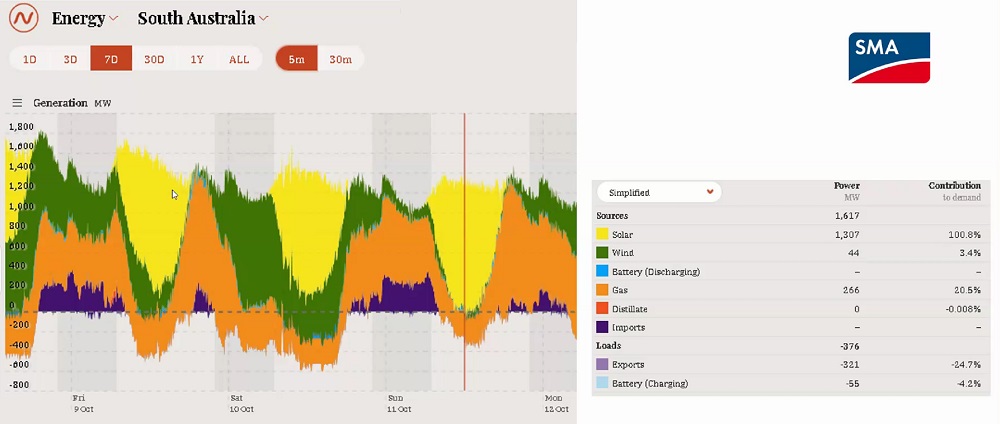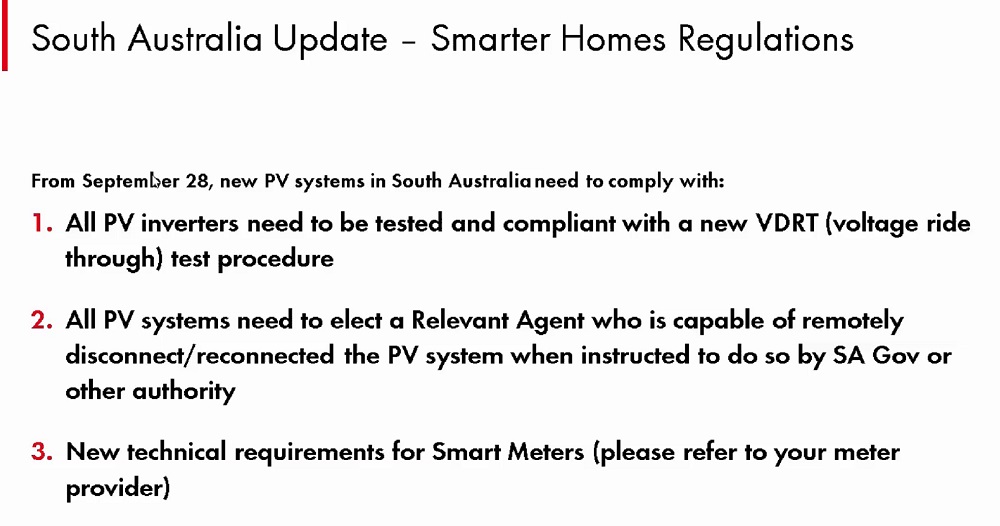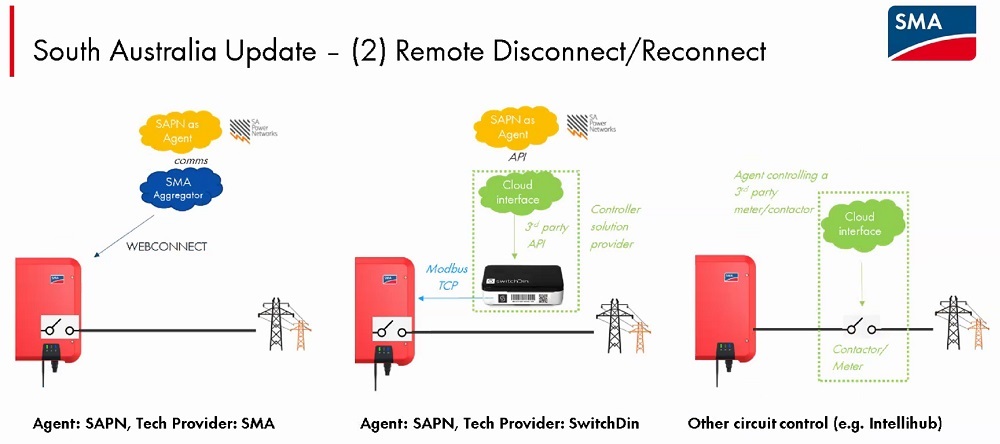
If SA needs to hit the big red button and shut down rooftop solar installed after 28 September 2020, SMA inverters can comply – at no extra cost to the owner.
On Thursday I was invited to a webinar on SMA’s response to South Australia’s new solar inverter requirements. It seems that SMA — the maker of Sunny Boy inverters — was on the ball as all their residential inverters are on SA’s approved installation list.
The Good News
Unlike some manufacturers, there will be no additional cost to meet the new Remote Disconnection/Reconnection requirement for most installations.
The Bad News
Unfortunately, when remotely disconnected, SMA inverters will shut down entirely preventing solar exports to the grid and stopping solar energy self-consumption.
No extra cost is good news, as one week ago I learned SolarEdge would charge an extra $165 in South Australia for remote disconnect/reconnect capability. However, SolarEdge inverters will still supply power to the home while remotely disconnected as they only shut down exports. While this is better, because I expect remote disconnections to average under a few hours a year, it should only be a minor consideration when choosing which inverter to go with.
New Requirements Rushed In
I was invited to the SolarEdge webinar two minutes before it started, but for SMA I had a lead time of 15 minutes. I used 7 of them to plan what I was going to have for dinner that night. When I tried to join the webinar I found it difficult because they used different software that I presume was German (or possibly Chinese to save on labour costs) and it took nearly 10 minutes to set things up. Luckily, the webinar started a little late and I didn’t miss anything.
South Australia’s new inverter requirements came into force on the 28th of September. The fact inverter manufacturers are having their webinars on it in October indicates how rushed the new standards were. Generally, large companies like to get these things sorted out before they come into force. While SMA didn’t exactly complain about the situation they did say…
“It’s been a very difficult month.”
Fortunately, SMA was on the ball, saw the writing on the wall, and avoided the balls-up that could have come from the sudden change. Their current range of inverters all meet the new requirements. The official list of approved inverters has all SMA inverters up to 40 kilowatts on it and we were told their 50-kilowatt one will be on it soon.
Update 20th October 2020: SMA have told me their 50 kilowatt inverter was already on the list and it’s their 110 kilowatt inverter that will be appearing on it soon.
Solar Over 100% Of SA Demand
The first thing we were shown once the webinar was underway was this graph of South Australian Electricity production. There’s a red line through Sunday the 11th of October when solar provided power 100.8% of state demand:
Including other sources, total generation was 124.7% state consumption. This wasn’t a problem because the extra power was being exported to Victoria, but if the Heywood interconnector went offline — as it does from time to time — the state would have had too much generation and rapid curtailment would be required to prevent blackouts.
Gas, wind, and solar farms can quickly reduce output…
…but existing residential solar can’t.
If rooftop solar power continues to expand without a way to control it then widespread blackouts could happen. This is because the only ways to shut down the rooftop solar systems would be to blackout the local area or increase network voltage to knock systems offline.
The latter is a ham-fisted method that will only be used as a last resort. And because blacking out homes and businesses upsets people, grid managers like to avoid it. It also terrifies the state government on account of the political fallout. They built up a lot of bad karma by continually bagging the previous government over grid reliability and have realised blackouts on their watch would not be a good look.
The New Inverter Requirements
This webinar slide shows the new requirements inverters must meet for installation in South Australia and perhaps the rest of the country before long:
The first one involves being able to handle a temporary low voltage grid disturbance without shutting down. SMA inverters have this down pat.
The second one is what has people in a tizzy as it involves inverters being remotely shut down when required for grid stability.
The third is to do with smart meters and letting them switch on loads such as hot water systems to help with grid management. SMA didn’t go into this.
3 Methods Of Remote Disconnection
There are three methods of enabling Remote Disconnection/Reconnection that can be used with SMA inverters. If you are installing a residential solar power system you should only ever need to use the first one that requires no additional hardware and no extra cost — provided your inverter can get a reliable internet signal.
The three different methods are shown in the graphic below:
All new SMA inverters are all capable of the one on the left, which involves SA Power Networks (SAPN) sending a disconnect/reconnect signal to the SMA online portal, which then instructs the inverters to disconnect from or reconnect to the grid.
The second method involves a piece of hardware called a droplet from SwitchDin. SMA says this approach may be used if an upgrade or replacement was being done at a site with more than one older SMA inverter. As it will normally be necessary for the entire site to meet the new requirements and older SMA inverters don’t have Remote Disconnection/Reconnection capability, the SwitchDin device will be required. But if an inverter was particularly old I’d consider if it was worthwhile to instead replace it with a new one.
SMA describes the final option as a last resort where the other methods won’t work. It involves installing a switch from an outside manufacturer that can disconnect or reconnect the inverter from the grid when a signal is received.
Reliable Internet Required
To comply with the new SA requirements all solar inverters will need reliable internet access. For SMA and probably every other inverter this will require a 4G signal, so some people may need to upgrade their router. A cheap one is under $100.
This need for reliable internet means my parents would be out of luck. Even though it’s 2020, theirs is less reliable than a jelly wind turbine1. However, they’re in Queensland and I don’t know if crap internet access is as common in SA. If there is a reliable mobile phone signal it may be possible to use third-party equipment to create a workaround, but this may not be cheap.
Perhaps low-quality internet connections will often be overlooked, as the state government won’t want its attempt to cover its arse on grid reliability to highlight problems with telecommunications.
Disconnections Will Be Rare
While SMA inverters won’t allow a home to continue to self consume solar power if they are remotely disconnected, these should be rare events. SMA said — or suggested — that SA Power Networks says they’ll only occur around once a year.
SolarEdge had a very different take on this because according to them, SA Power Networks said they’d happen about 20 times a year.
They may both be right as there could be a total of around 20 events a year across the state but, because they’ll only cover a limited area, an individual home may only be likely to experience around one of them.
But it is interesting the company whose inverter can supply solar power to the home during a disconnection event mentioned a far higher figure. And vice-versa.
No Extra Cost Is A Relief
I’m relieved SMA isn’t charging anything extra for their inverters in South Australia. Hopefully, there will also be other manufacturers who won’t see the need to bump up their price. One thing I would watch out for is any company trying to sneak in an annual charge for Remote Disconnection ability. I hope the SA Government won’t be dumb enough to allow that. A billing dispute could result in your inverter no longer meeting SA requirements and being remotely shut down for good.
Footnotes
- When they complained to the ombudsman he just put them through to Tony Abbott who said, “Do we really want to invest $50 billion of hard-earned taxpayers money in what is essentially a video entertainment system?” I thought that was a bit rough, as my parents were only asking for a $1 billion upgrade. ↩





 RSS - Posts
RSS - Posts



Hi Ronald,
What’s required to get an SMA inverter to still continue to supply the house in a grid outage? I’ve got an SB5.0-1AV- 40 which is too old apparently as its not on the approved list. Can that be done without a battery?
I’m afraid you’d have to replace it with a Sunny Boy Storage hybrid inverter configured for backup. As far as I know, it will require a battery. Or you could use a different hybrid inverter. There are ones that will allow a home to use power from solar panels during a grid outage without a battery, but it is difficult to manage as output varies through the day and clouds can cause sudden drops in output.
Well now there needs to be a clever person that can write some illegal SunnyBoy software so that you can at least use your own power. Seriously who is going to buy a Sunny Boy if the Government can shut you down anytime they like. Most people probably won’t even know they’ve been shut off and worse, some batteries like LG Chem switch themselves off in the absence of power and won’t turn back on without manual intervention.
I’m afraid it would need additional hardware to enable the inverter to supply the home while cutting off exports. Hacking a standard inverter so it doesn’t shutdown when it is supposed to could kill line workers and so is frowned upon.
The purpose of hitting “the big red button” is of course to bring supply and demand back into balance. This will be achieved more effectively if consumers can not use their locally generated power, so perhaps this is a good thing. I can understand some will be upset by this but the cost of a few hours per year of grid power is going to be minimal. I am upset to think that maybe I’m the only person with more significant things to get upset about.
When your grid connect switch ‘drops out’ a simple ? low wattage single phase inverter connected to your standard inverter and powered by a 12 V.D.C. battery may trick it into thinking it still has a 50 Hz 230/40 V.A.C. source connected to its output. The battery can be connected to a small charger powered from your now working inverter !!!
(perpetual motion, anybody ?).
p.s. to also have a small wind powered turbine running as well may even give a nighttime power source.
If you’re on Amber Electric’s tariff you’re charged the wholesale rate, which I would assume would be negative at these times? Therefore are you actually better off not using your own generation as you’d be effectively buying your power in at a negative cost, so not only are you not paying to export your excess generation, but you’re being paid to use electricity from the grid?
Re. South Australia’s Remote disconnection rules
Does the Huawei 5kw SUN2000L-5KTL inverter supply power to the home even when remotely disconnected?
The above article advises the Solar Edge inverters allow self consumption even when exports to the grid are stopped. Is this still the case?